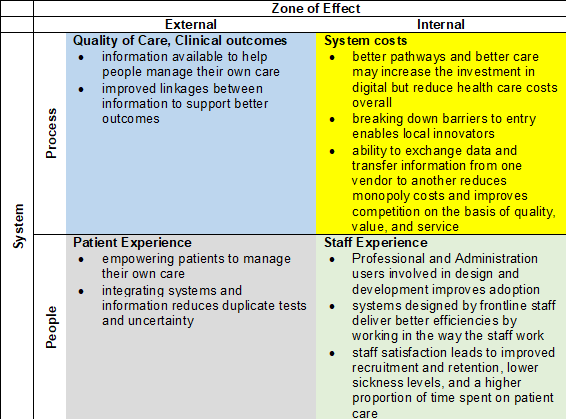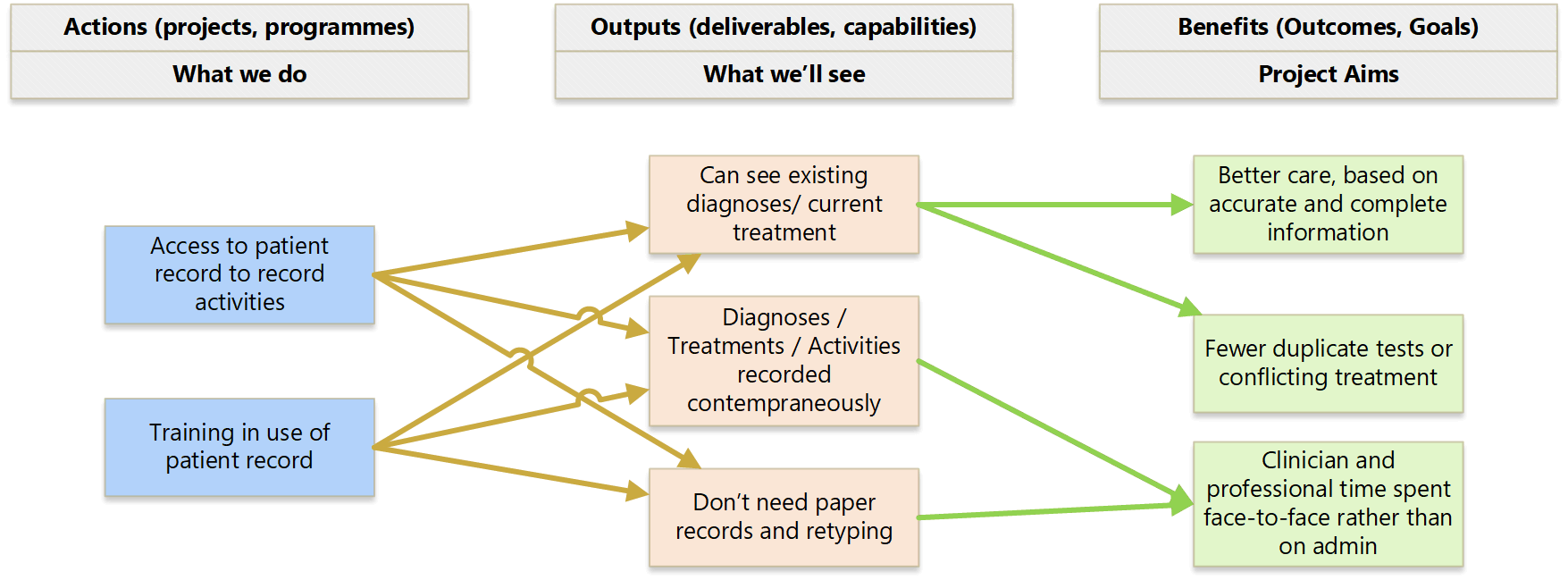Outputs
Benefits Realisation Management is talked about but not often practiced, so it is unclear whether the investment in digital technology is actually delivering a return on investment (Casey & Waring, 2014; Waring et al., 2018; Waring et al., 2014).
Benefits management (BM) is the identification, definition, planning, tracking and realisation of business benefits. It is an iterative and cyclical process which is sustained beyond the project (includes programme and portfolio management) to review and manage benefits for the whole lifecycle of a change initiative (APM, 2012a).The purpose of the process is to improve the identification of the achievable benefits and to ensure that decisions and actions taken over the lifetime of the investment lead to realizing all the feasible benefits” (Ward & Daniel, 2005) quoted in (Gomes & Romão, 2016)
A benefit is defined by the Cabinet Office as “the measurable improvement resulting from an outcome perceived as an advantage by one or more stakeholders, which contributes towards one or more organisational objectives”. (IPA, 2017)
Benefits Realisation Management is the Holy Grail – everybody wants it, not many people can describe what it looks like, and no-one seems to know where to find it.
Benefits can be tangible (e.g. money saved/made, jobs created) or intangible (e.g. corporate reputation, capacity for change). They may, or may not, also be quantifiable in cash terms (e.g. reduced costs or greater customer satisfaction) (APM, 2012b Section 3.2.1).
Benefits Realisation Management is both a reporting tool, and a tool to help make the right decisions so that your project and the required business changes influence positive outcomes and realisation of expected (and unexpected) benefits.
Many studies have identified what makes one project successful and another not, or why some organisations have a higher proportion of their projects delivering return on investment (Gomes & Romão, 2016; Hardy-Vallee, 2012; Lahmann et al., 2016; PMI, 2016, 2017, 2018). These studies have generally found that a focus on Benefits Realisation Management (i.e. keeping in mind why we are doing the project or programme in the first place) vastly increases the likelihood of a project or programme being deemed a success, regardless of whether success is measured by compliance with the iron triangle (time, cost and scope), delivery of benefits, or in the opinion of the stakeholders.
Benefits realisation management has the other advantage that if you are assessing the success or otherwise of the project, then you can make decisions more likely to lead to future success.
The benefits broadly fall into a balanced scorecard; one is illustrated below where we have suggested benefits appropriate to an Open Source innovation.
Figure 3‑1 An example Balanced Scorecard for digital projects in the NHS

A BDN is a simple visual presentation of the components of change and delivery of success for a project, programme or portfolio.
It is NOT an end in itself. It’s a way of representing the various components, and what is dependent on what.
The simplest BDN links the project to its outcomes and what these mean in terms of benefit.

A BDN can be read from right to left, in other words “in order to get this benefit, what do we need to do?”.
It can also be read from left to right: “if we do this, then what is likely to be the result?”
Typically most projects and programmes begin with a problem that needs solving or an opportunity. Most projects and programmes begin with creating the BDN from right to left. However it’s worth then examining what will happen, working from left to right, to discover what synergistic benefits may result, what risks, and what dis-benefits (effects that you might not want). As Figure 4‑2 Aligning Benefits Management Actions with Project Management Actions illustrates, a BDN should be prepared at Project Initiation to quickly assess whether the benefits outweigh the investment and risks; the BDN should be revised in some depth for the Full Business Case (a business case is a description and explanation of the benefits compared to investment and risks); and the BDN should be referred to when making decisions during project delivery, and updated when decisions are made.
For this reason, it’s often useful to use a tool which can track the amount of activity and amount of benefit and respond to any changes that result. One such tool is Amplify.










